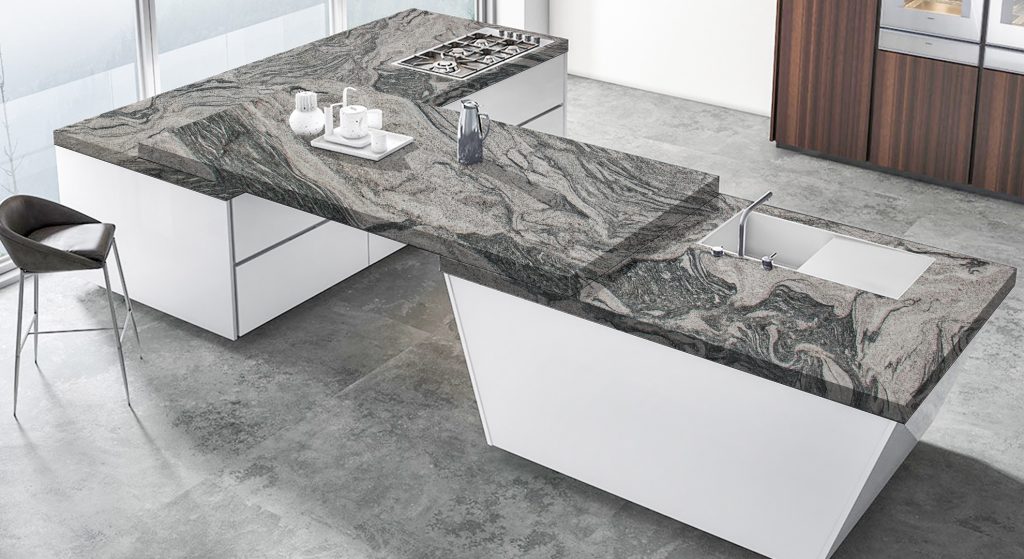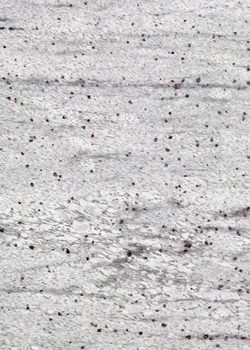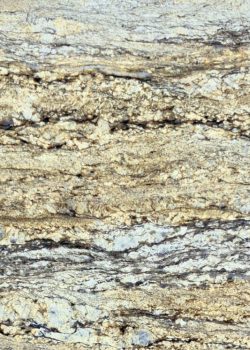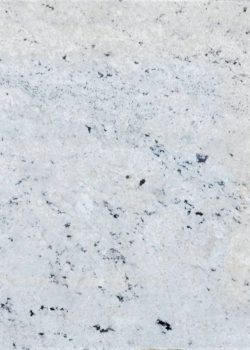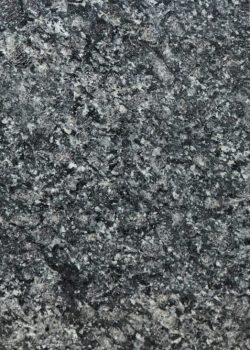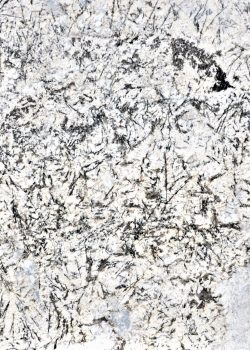HISTORY
Originating 300 million years in the past, this natural stone holds the title for the oldest igneous rock in the world and boasts a rich history. Granite is formed when molten stone, also known as magma, undergoes cooling, followed by slow crystallization for an extended period of time before surfacing on Earth. It is extensively distributed throughout the Earth’s continental crust and displays a medium to coarse texture comprising of several minerals, such as feldspar, mica and quartz. Its varying composition translates into an exquisite palette of colors, including white, brown, pink, yellow, green, grey, red and black.
The term ‘granite’ originates from the Latin word “granum” which means ‘grain’. It refers to the prevalent, course-grained composition found in this category of crystalline rock. This natural wonder is most quarried as ‘dimension rock’ which refers to a natural rock material destined for cutting into blocks or slabs of pre-determined dimensions of length, width and thickness.
With a rich historical heritage, granite has been a cornerstone of construction since ancient times due to its longevity and wide availability.
For instance, the Great Pyramid of Giza, boasts a massive granite sarcophagus (a stone coffin, typically adorned with a sculpture or inscription and associated with the ancient civilizations of Egypt, Rome, and Greece) crafted from red Aswan granite. Moreover, numerous expansive Hindu temples in southern India, particularly those attributed to the 11th century ruler, Rajaraja Chola I, used granite. The volume of granite used in these temples is believed to rival that employed in the Great Pyramid of Giza.




CHARACTERISTICS AND BENEFITS
Composition: As previously mentioned, granite comprises of several mineral such as mica, feldspar and quartz. In addition, it also comprises of minerals like, hornblende, biotite, and pyroxene.
Colours: Granite is available in a variety of colours, being, white, brown, pink, yellow, green, grey, red and black.
Durability and Resistance: This natural stone is known to be very durable as it can withstand wears and tears and has resistance to acids. Its low porosity enables it to be resistant to water absorption and weathering. Thus, it is a popular choice for floorings, countertops, walls and more.
Reactivity: Granite is generally not reactive with other chemicals, hence, it can be used in various places without being affected by chemical reactions.
Texture: The texture of granite is usually coarse-grained and granular, with visible mineral grains.
DISADVANTAGES
Porous: Like marble, granite has pores and hence, it considered porous. Therefore, various liquids and moisture may be absorbed in the material over time that can lead to staining or darkening of the material.
TYPES
Granites can be differentiated on the basis of colour and pattern. Colours include white, pink, yellow, green, red, brown, black and grey.
WHY IS IT USED IN ARCHITECTURE AND DESIGN
Granite has been quite often used in public and commercial building as well as monuments owing to its enduring elegance and impressive robustness. Within homes, it is a favourite pick for kitchen countertops owing to its low reactiveness with other chemicals. Furthermore, its resistance towards acids acts as a helping hand and makes it a popular choice for places that experience acid rain.
However, like marbles, selectors must be careful in choosing granite as quality and durability of granite differ depending on the location and company it is taken from. Having said that, as granite offers a colourful panorama of patterns and hues, architects, home contractors, customers and more are bestowed with a spectrum of choices allowing them to choose the best option that enables them to bring their vision to life.
For more details log on our website : www.alasalmarbles.com or write us email : info@alasalmarbles.com
Follow our social media for regular updates...
Tag : Neolith, Cladding, Natural stone, Cladding materials, Selecting the best cladding material, Exterior, cladding, High-rise buildings, Most popular cladding material, Limestone, Travertine, Current trend in cladding, Quartzite, Choose a marble for kitchen top, Kitchen Islands, Natural marble top, Marble Countertop, Highly durable stone, Preferred options for the kitchen tops, Granite Counter tops, Cleaning the granite counters, Kitchen countertop, Best kitchen countertop, Marble, Marble, kitchen tops, Natural stones, Designing your kitchen, Granite, Caesarstone, Sintered stones, Marble and granite suppliers in UAE, Kitchen Counter, How to select kitchen counter, Quartz Slabs, Slate, Countertop options, Quartzite countertops, Cleaning quartzite countertops, Sintered Stone, Kitchen surface, Advantage of Neolith, Countertop designs, Quartz countertops, Budget friendly, kitchen countertops, Feature wall, Natural stone cladding, Granite cladding, AL ASAL MARBLE, Adhesive, Marble adhesive, Floor, Flooring, Commercial, Projects, Projects, Stones, Stones, Internal, External, Walls, Flexible, Countertops, Wall cladding, Engineered stone, Stone adhesive, Marble fixing, Marble flooring, Waterproofing, Sealing, Sealant, Marble cleaning, Marble suppliers in UAE, Marble manufacturer, Stains in marble, Marble sealer, Leading marble company in UAE, Best Marble company, Marble protection

